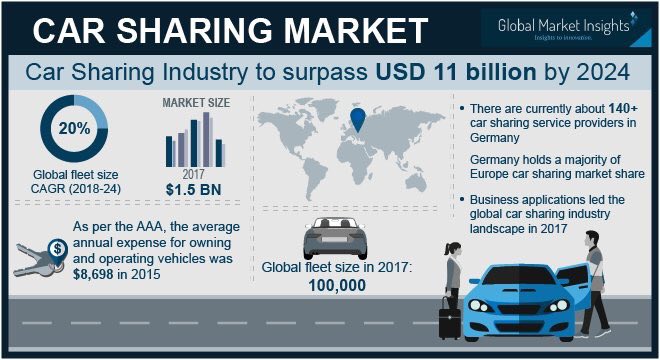Cars require a lot of maintenance and are a costly investment; due to this more people are turning towards car-sharing for their commute to work. Another demographic looking towards car-sharing as a preferred mode of transport is the public transport commuter.
Especially in countries like India, China, and Argentina, many depend on public transport – however, they are worried about overcrowding and theft whilst traveling. Car-sharing is picking up as a positive trend that has more benefits than just a comfortable commute to work but also helping with the environment and economy.
The overall car-sharing market was valued at USD 33.5 billion in the year 2018, by the year 2024, the car-sharing market is predicted to surpass 11 billion USD. Between the years 2017 to 2024 the car-sharing industry the CAGR is said to increase by 20%.
The increasing demand for mobility-on-demand services will be a key driver for the car-sharing market in the coming years. Car sharing allows passengers to travel short distances for a nominal fee since there are many companies within the market customers can choose from many services offering a wide range of competitive price points. ZipCar in the US offers its rental car-sharing services between 17-35 USD depending on the trip, whilst in the UK it costs between 17-23 USD for a one hour trip.
Business models:
The P2P market is predicted to bring about growth for the car-sharing market. People are renting out their vehicles to car rental services when not in use for a monetary value. This will play a major role in reducing the number of cars on the roads, therefore reducing emissions.
Another factor affecting the shared mobility demand will be the one-way car-sharing model. This is more convenient for people who want to go short distances as it allows them to park or drop off their vehicles anywhere. In the year 2017, the American Automobile Association introduced Gig – a one-way ride-sharing service that allows customers to pick up and leave the car at a place of their choosing. It has been launched in Oakland and Berkley.
Application:
Businesses are now concerned about sustainable travel solutions, as well as, the safety and comfort of their employees. Therefore many are adopting car-sharing to ensure that their employees are picked up and, reach the workplace safely and on time. The B2B car-sharing market is anticipated to a CAGR of 33% over the coming years.
Region:
A 30% growth in the industry is expected within the Asia Pacific region between 2018 and 2024. Due to a rapid population increase in countries like China and India and public transport becoming overcrowded, more and more people are opting for car rental services.
Key players:
Many companies are competing within the industry – Turo Inc., Lyft Inc., Zipcar Inc., and Hertz Corporation are a well known few currently in the market.
Automobile manufacturers are also getting in on the action. In 2019 BMW and Daimler collaborated to introduce an environmentally friendly car-sharing service for customers using electrical vehicles (EVs) with an investment of 1.10 billion USD. Within the same year, Tencent and Alibaba announced their partnership in introducing a car-sharing service powered by renewable energy. They invested 1.45 billion USD for this venture.
The main benefit of car sharing becoming a widely used service is that it is environmentally friendly, and many people are prioritizing sustainability above all else. During May 2019 Canada was the first country to sign on to the international initiative Drive to Zero pledge to increase low or zero-emission vehicles on the roads. This will automatically encourage people to opt for more sustainable travel options like car sharing. The rise in EVs purchased by car rental companies will also contribute to the growth of the car-sharing market.
As of now the car-sharing market is on a rise and will only continue to grow.






























